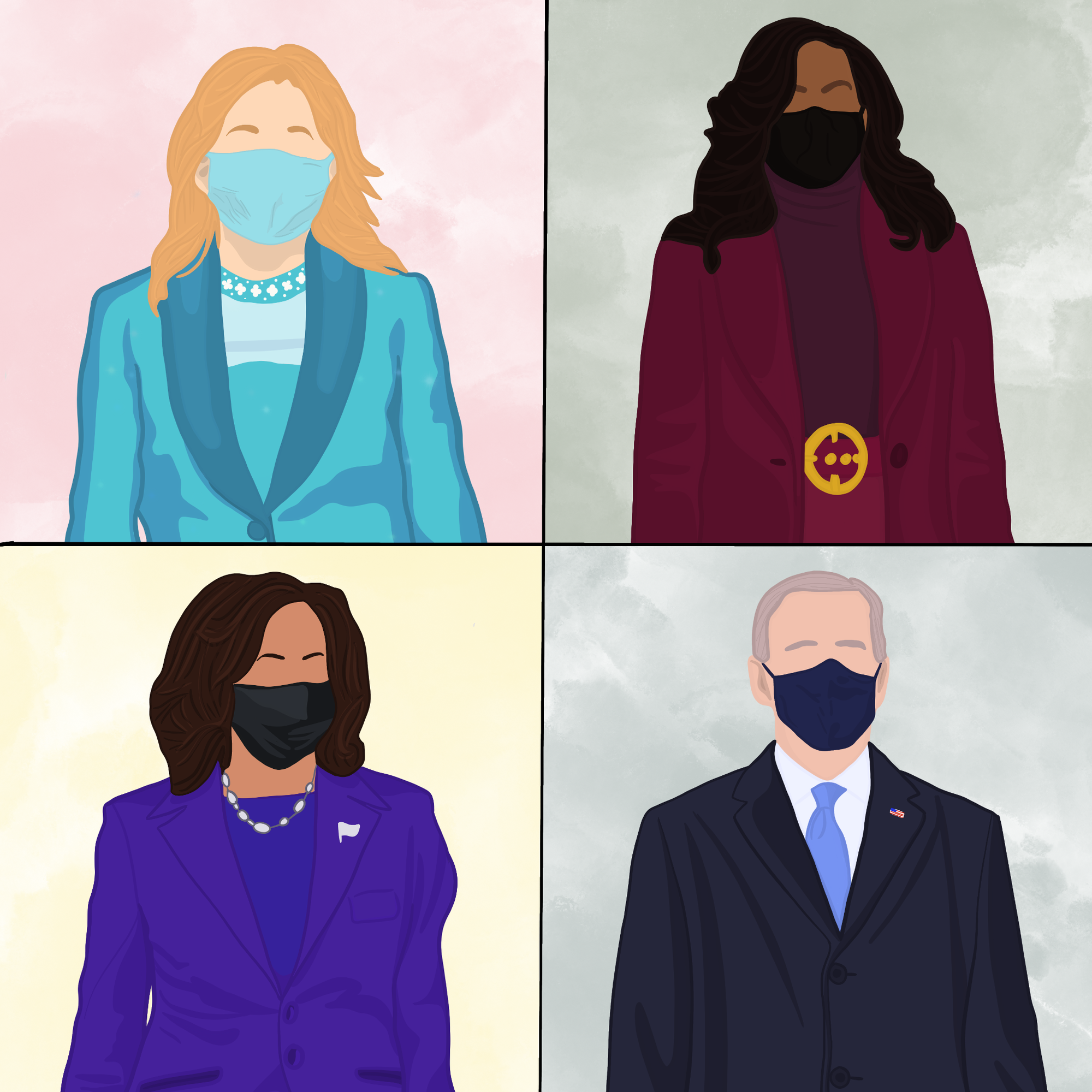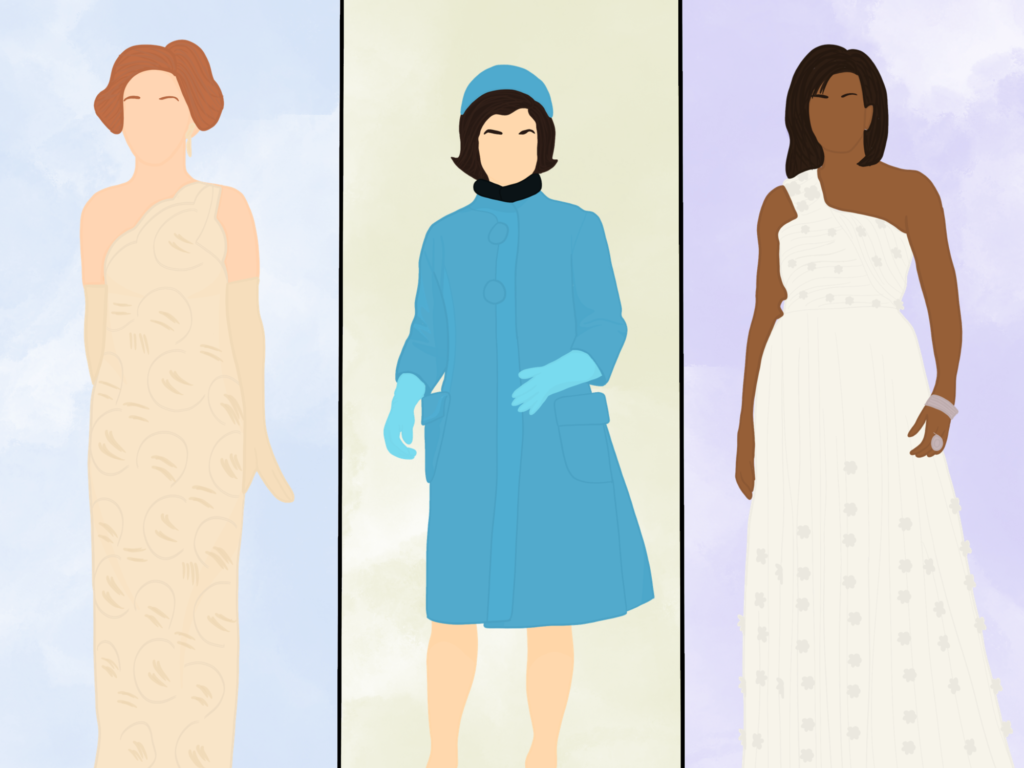The Quad: Stitching together the common threads of fashion choices at inaugurations

(Jaelen Cruz/Daily Bruin)

By Sara Hubbard
Jan. 27, 2021 2:21 p.m.
How much impact can a single outfit have?
If you’re on the steps of the Capitol at a United States presidential inauguration, the answer is quite a lot.
Clothing may seem like an afterthought when it comes to matters of national importance – and while it is true that the peaceful transition of power takes center stage at any inauguration, sartorial choices can mean more than just looking sharp.
Decisions such as what color and which designer to wear all communicate messages to the public, said Deborah Landis, the founding director and chair of the David C. Copley Center for Costume Design.
“Whether intentional or not, clothing is always speaking,” Landis said. “When you leave the house, from your shoes to your jeans or your sweats, to the jewelry that you’re wearing to the piercings in your ear, everything is speaking for you.”
The intersection of fashion and politics in modern times can largely be traced back to Jacqueline Kennedy, whose signature bespoke suits and pillbox hats launched the first lady-ship into popular culture.
At John F. Kennedy’s inauguration in 1961, Jackie wore a tailored baby blue suit and egg-shaped pillbox hat designed by Roy Halston Frowick’s Halston label. After Jackie put him in the spotlight, it wasn’t long before Halston, a relatively unknown designer, became one of the most influential designers in American fashion history.
When former first lady Michelle Obama wore a white one-shouldered Jason Wu gown to one of the inaugural balls in 2009, it made headlines that she had chosen a young, fresh Taiwanese Canadian designer – and for good reason. It showed that Obama was deliberate in using her newfound platform to lift up an artist.
Shoshanna Lonstein Gruss, a UCLA alumna and the eponymous owner of her Shoshanna label, said for a designer, having one’s clothes worn at an inauguration is one of the highest honors there is.
“It’s priceless in so many ways,” she said. “You become part of history, which is, to a designer, magical.”
This year was no different. President Joe Biden and second gentleman Doug Emhoff both chose Ralph Lauren, the quintessential American designer whose label has been worn by countless politicians since its inception in the 1960s. Choosing an American designer has always been considered a declaration of national pride, tying back to Brooks Brothers being a favorite of presidents since the 1800s.
First lady Jill Biden took the inauguration as an opportunity to showcase Alexandra O’Neill of Markarian, a woman-run label based out of New York. Jill’s ocean-hued coat and matching silk mask took the heretofore obscure atelier and lifted it up to the national stage, all the while communicating a message of support for female-led enterprises.
Marissa Shankar, a fourth-year business economics student and vice president of Fashion and Student Trends, said fashion choices for an inauguration are weighted more than those for events such as the Met Gala or the Oscars, so politicians must be exacting in making their decisions.
“What they wear … will end up sending a message of who they support, the purposes that they support,” Shankar said. “(Markarian is) a made-to-order designer brand, so they’re considered more sustainable than the ones who design for mass market, … (and) people have related that to Biden’s mission for climate change.”
The significance of a given fashion moment goes well beyond the chosen designer. When Jimmy Carter was sworn in as president in 1977, he wore a suit he purchased for $175 just a week before the event took place, reinforcing his platform of humble peanut farmer turned president of the people.
Barbara Bush similarly used her fashion choices to place an emphasis on what she viewed as more pressing issues. The former first lady famously wore faux pearls – a conscious affront to frivolity and a reminder to the populace that she was a woman of practicality.
Juxtapose this with Nancy Reagan, who brought her Hollywood sensibilities to the White House and was largely criticized for what many considered to be an irresponsible amount of spending on gowns and jewelry. At the balls celebrating Ronald Reagan’s second inauguration, Nancy wore $46,000 worth of gowns, helping earn the first lady the nickname “Queen Nancy.”

Meanwhile, Elena Manferdini, a UCLA alumna and architect whose firm Atelier Manferdini has worked on the clothing and design projects of various fashion designers, said focusing on what women in the political sphere wear can sometimes distract from their actual work.
“I for certain can say that women in politics can never win when it comes to fashion, damned if they do and damned if they don’t,” Manferdini said in an emailed statement. “(Vice President Kamala) Harris is a beautiful, confident, capable leader. … I want to think of her at work, wearing whatever she desires, without worrying about (it) becoming a matter of national discourse.”
And it’s true, Harris’ clothing choices are in no way the most critical aspect of her job. But to Landis, attention to detail in clothing can be associated with a similar attention to detail to one’s political platform.
“I think that those who say that caring about clothes diminishes a woman – that’s a sexist statement,” Landis said. “I would say to those people, ‘You’re thinking about clothes on the most superficial level. … Think deeper about how we communicate in a nonverbal way.'”
On Jan. 20, Harris wore a purple dress and coat by Christopher John Rogers, a Black American designer. Michelle Obama and Hillary Clinton also wore aubergine hues. This choice of color is not a coincidence – Landis said purple represents unity in American politics. It is after all what you get when mixing the Republican Party’s red and the Democratic Party’s blue. It also represents the women’s suffrage movement, which is celebrating its 100th anniversary.
Many women also chose to wear pearls, which Gruss said symbolizes strength and perseverance.
“(Pearls) are something that start off as sand and go through the tremendous pressure of … going from grains of sand to a beautiful pearl,” she said. “That was a really nice representation of femininity and strength and grit.”
At the end of the night, Jill Biden waved from the Truman Balcony in a white Gabriela Hearst coat and dress featuring floral embroidery. To some, it was simply an outfit change. But upon closer inspection, Biden’s dress and coat were perhaps the most meticulous example of fashion symbolism that day.
The flowers stitched along the hem were the official flowers of every state and territory in the U.S. From the California poppy to the Delaware peach blossom, her outfit was a symbol of unity and national pride.
For Gruss, the first lady’s coat epitomizes the significance of the inauguration.
“(A lot of these outfits) will end up in the Smithsonian someday,” Gruss said. “Some boy or girl or man or woman will see that dress … and see the flower of their state or territory and feel proud and honored that they’re part of that country that came back and defeated this terrible virus and came together.”
Landis said the way the Biden-Harris team presented themselves on inauguration day makes her hopeful for the future of the country.
“If the administration is as thoughtful and caring as they are in policy as they were in their sartorial choices, I think we’re in good hands,” she said.


